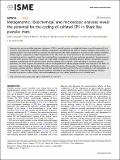Metagenomic, (bio)chemical, and microscopic analyses reveal the potential for the cycling of sulfated EPS in Shark Bay pustular mats
Author(s)
Skoog, Emilie J; Moore, Kelsey R; Gong, Jian; Ciccarese, Davide; Momper, Lily; Cutts, Elise M; Bosak, Tanja; ... Show more Show less
DownloadPublished version (3.856Mb)
Publisher with Creative Commons License
Publisher with Creative Commons License
Creative Commons Attribution
Terms of use
Metadata
Show full item recordAbstract
<jats:title>Abstract</jats:title><jats:p>Cyanobacteria and extracellular polymeric substances (EPS) in peritidal pustular microbial mats have a two-billion-year-old fossil record. To understand the composition, production, degradation, and potential role of EPS in modern analogous communities, we sampled pustular mats from Shark Bay, Australia and analyzed their EPS matrix. Biochemical and microscopic analyses identified sulfated organic compounds as major components of mat EPS. Sulfur was more abundant in the unmineralized regions with cyanobacteria and less prevalent in areas that contained fewer cyanobacteria and more carbonate precipitates. Sequencing and assembly of the pustular mat sample resulted in 83 high-quality metagenome-assembled genomes (MAGs). Metagenomic analyses confirmed cyanobacteria as the primary sources of these sulfated polysaccharides. Genes encoding for sulfatases, glycosyl hydrolases, and other enzymes with predicted roles in the degradation of sulfated polysaccharides were detected in the MAGs of numerous clades including Bacteroidetes, Chloroflexi, Hydrogenedentes, Myxococcota, Verrucomicrobia, and Planctomycetes. Measurable sulfatase activity in pustular mats and fresh cyanobacterial EPS confirmed the role of sulfatases in the degradation of sulfated EPS. These findings suggest that the synthesis, modification, and degradation of sulfated polysaccharides influence microbial interactions, carbon cycling, and biomineralization processes within peritidal pustular microbial mats.</jats:p>
Date issued
2022Department
Massachusetts Institute of Technology. Department of Earth, Atmospheric, and Planetary SciencesJournal
ISME Communications
Publisher
Springer Science and Business Media LLC
Citation
Skoog, Emilie J, Moore, Kelsey R, Gong, Jian, Ciccarese, Davide, Momper, Lily et al. 2022. "Metagenomic, (bio)chemical, and microscopic analyses reveal the potential for the cycling of sulfated EPS in Shark Bay pustular mats." ISME Communications, 2 (1).
Version: Final published version